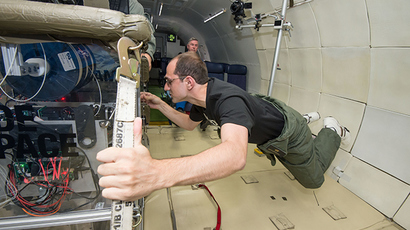NASA, SpaceX adapting 3D-printing for space exploration

The inability to print solid 3D objects from several different alloys, a challenging obstacle to using such parts in spacecraft, has been overcome by NASA. Meanwhile, SpaceX announced it actually used a 3D-printed part in a rocket launched in January.
When creating a product on a standard 3D printer, only one material is usually used in the process. Overcoming the problem that prevented the use of 3D printing in space technology construction, NASA’s Jet Propulsion Lab, together with Caltech and Penn State University, have built the first real-life composite part – a mirror mount made of several different alloys.

“You can have a continuous transition from alloy to alloy to alloy, and you can study a wide range of potential alloys… We think it’s going to change materials research in the future,” R. Peter Dillon, a technologist at JPL, said in a NASA press release.
The new technological process allows a 3D printer to switch between different types of alloys while creating a single part, thus tweaking its properties – including melting temperature, density and other – separately at different ends of the object. The project was first imagined by the team who’s successfully landed Curiosity on Mars, NASA says.
Although this is not the first time an alloy per se was created with a 3D printer, since previously the process involved the creation of gradient alloys in certain research and development projects, it’s still the first time the technology has been used to create a useful object, according to mechanical engineer John Paul Borgonia.
What further sets the process apart is that unlike welding objects together, the connection which may later prove too fragile, this process creates a solid multi-alloy part from the start. This is absolutely indispensable in creating complex parts for spaceships, because having to fix something like that in space would prove immensely difficult.
The technique to achieve this technological feat has been in development since 2010. After Curiosity landed safely on the Red Planet, NASA began to take 3D printing using this method further.
Douglas Hofmann, a researcher in material science and metallurgy at JPL explained how the team was taking a “standard 3D printing process and combining the ability to change the metal powder that the part is being built with on the fly.”
“You can constantly be changing the composition of the material,” Hofmann added. And by employing a rotating rod when melding the alloys together, the transition is made from inside out, rather than a traditional layered 3D printing.
The team believes the possibilities are endless – from machinery and industry here on Earth to complex space exploration tools on Mars.
In the meantime, SpaceX has set another milestone in the developing technology, announcing this week that they actually used a simple 3D-printed element in their rocket launched back in January. Printed of high performance superalloy Inconel, the 3D-printed Main Oxidizer Valve demonstrated a superior strength, ductility, and fracture resistance, the company said. And compared to traditional casting cycle of several months, the part was printed in less than two days.
“On January 6, 2014, SpaceX launched its Falcon 9 rocket with a 3D-printed Main Oxidizer Valve (MOV) body in one of the nine Merlin 1D engines. The mission marked the first time SpaceX had ever flown a 3D-printed part, with the valve operating successfully with high pressure liquid oxygen, under cryogenic temperatures and high vibration,” the company said.
“For almost 3 years, SpaceX has been evaluating the benefits of 3D printing and perfecting the techniques necessary to develop flight hardware,” the company said, adding that right now they are testing a much more complex 3D-printed part – an engine chamber for SuperDraco, that will power the launch escape system of the Dragon Version 2 spacecraft.















